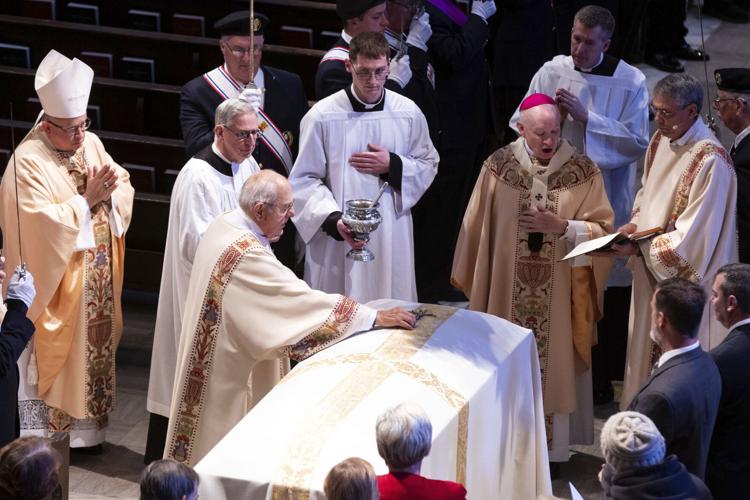FORT CALHOUN, Neb. (AP) — The grisly killings of a retiree and then a priest has shocked everyone in tiny Fort Calhoun, Nebraska, including Sheriff Mike Robinson.
He’s lived in the community just north of Omaha for 62 years and can’t recall a single homicide before these two.
“It really is out of character,” Robinson said. “It’s a good town, good place to live, good place to raise your family.”
Robinson says people have been troubled not only by the killings, but by the awful details of how their neighbors died in what appear to be random attacks.
Linda Childers, 71, was killed Aug. 13, when she was shot with a crossbow three times and her throat was slit at her isolated home near a creek about a mile north of Fort Calhoun. Less than four months later, on Dec. 10, the Rev. Stephen Gutgsell, 65, was fatally stabbed during a break-in at the rectory next door to St. John the Baptist Church, where he had been set to lead Mass later that day.
The brutal killings have shaken residents who have grown accustomed to a certain peacefulness in Fort Calhoun, a single-stoplight town of 1,100 nestled in rolling hills along the Missouri River. The town is only 8 miles (nearly 13 kilometers) from Omaha but seemingly a world away from the state’s biggest city and its nearly half-million residents.
The killings undercut Adam Schutte’s “warm and cozy” image of a small town.
“It’s scary,” said Schutte, while having a drink recently at the Longhorn Bar and Grill. ”It makes you wonder for sure.”
Usually, the talk in Fort Calhoun revolves around topics like the high school boys basketball team and its improbable run to the state tournament last spring for the first time in 99 years. But such milestones have taken a back seat lately.
Denise O’Neel has been spending one week a month at her fiance’s home in Fort Calhoun for years, so she knows it well. She’s not as confident in its safety anymore.
“As soon as he goes off to work my door is locked now,” O’Neel said. “I just know little Fort Calhoun doesn’t feel as safe as it used to.”
Fort Calhoun traces its roots to a meeting between explorers Meriwether Lewis and William Clark and the Oto and Missouri tribes in August 1804 — 63 years before Nebraska became a state.
The community has long offered a window into the past through living history programs at a reconstructed fort that dates to 1820. Volunteers dress up in clothing from the Old West and act out scenes from the period when the area was first settled. The high school sports teams are called the Pioneers.
At the time of her death, Linda Childers had lived in Fort Calhoun for nearly 50 years. Police arrested William Collins, 30, about two weeks after she was killed. He was found in Texas with Childers’ car and some of her property.
Kierre Williams, 43, was arrested in Gutgsell’s home. When a deputy arrived, Williams was sprawled across the priest, who was bleeding profusely.
Both men face murder, burglary and weapons charges, and are due back in court early next month. Authorities say Williams had a job at a meatpacking plant in Sioux City, Iowa, while Collins was a self-described “minimalist” who was camping out near the river for about a week.
It’s not clear what brought either of them to Fort Calhoun and investigators haven’t found any connection between them and the victims.
Collins’ attorney has said he plans to plead not guilty but declined to discuss the case. Williams’ attorney with the Nebraska Commission on Public Advocacy didn’t respond to a message.
For some, the deaths have shaken their belief that Fort Calhoun is inoculated from the violence they hear of in Omaha and other big cities.
Childers’ stepdaughter, Wendy Sue Childers, spent much of her childhood in Fort Calhoun with her dad and stepmother, who she considered her best friend. Now a Missouri resident, she said the news of Gutgsell’s killing so soon after her stepmother’s death has her questioning whether any place is truly safe.
“I don’t know what’s happening,” she said. “It’s just spreading. It is spilling over into the rural communities that are quiet and peaceful and minding their own business.”
The priest’s killing resonated so deeply that people who don’t regularly attend St. John the Baptist mixed with his parishioners to fill the small church at a vigil the day he died. On Monday, mourners nearly filled an 1,000-seat cathedral in Omaha for Gutgsell’s funeral, where he was remembered as a movie buff who was deeply concerned about making sure people were ready to meet God, particularly when they died violently like he did.
Longtime resident Mike Cimino said the killings have been jarring, but they haven’t changed how he feels about Fort Calhoun. He’s always liked that he could get his kids to their Catholic school in central Omaha in only 20 minutes or so, and anytime he needs to make a Costco run, the big city is just minutes away.
“I would feel probably less safe in a bigger city than here,” he said. “I think it’s just a coincidence that this had happened.”
Robinson, the sheriff, notes Fort Calhoun is safe by nearly any measure, with almost no thefts, burglaries or vandalism.
“I’m sure that they’re concerned and they’re scared,” Robinson said of residents. “We just try to reassure them that they’re just as safe now as they were for the last 10, 15, 20 years.”
As she picked up a few gift bags at the Dollar Tree, Debbie Shultz said she still feels safe but acknowledged the deaths weigh heavily.
“Of course it makes you apprehensive, but it’s still my sweet little town and I wouldn’t trade it for anything,” she said.
___
Beck contributed to this report from Omaha, Nebraska.





